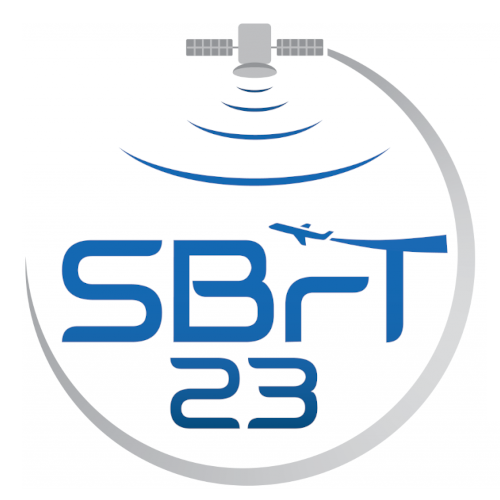
XLI Simpósio Brasileiro de Telecomunicações e Processamento de Sinais
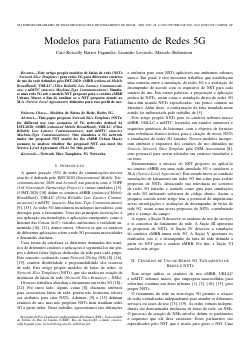
Modelos para Fatiamento de Redes 5G
Caio Roscelly Barros Fagundes, Lisandro Lovisolo, Marcelo Gonçalves Rubinstein
DOI: 10.14209/sbrt.2023.1570923294
Keywords: Modelos de Fatias Redes 5G Network Slice Templates 5G Networks
Abstract
Este artigo propõe modelos de fatias de rede (NSTs - Network Slice Templates) para redes 5G para diferentes cenários de uso da rede definidos pelo IMT-2020: eMBB (enhanced Mobile BroadBand), URLLC (Ultra Reliable Low Latency Communications) e mMTC (massive Machine-Type Communications). Simula- se uma rede 5G sob o modelo NST proposto para o cenário eMBB Urbano Macro a fim de analisar se a NST proposta atende ao SLA (Service Level Agreements) definidos para esse perfil de uso.Download
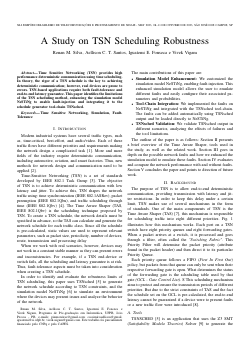
A Study on TSN Scheduling Robustness
Renan M. da Silva, Aellison Cassimiro Teixeira dos Santos, Iguatemi E. Fonseca, Vivek Nigam
DOI: 10.14209/sbrt.2023.1570923319
Keywords: Time Sensitive Networking Simulation Fault-Tolerance
Abstract
Time Sensitive Networking (TSN) provides high performance deterministic communication using time scheduling. In theory, the rigor of a TSN schedule is the key to achieving deterministic communication; however, real devices are prone to errors. TSN-based applications require both fault-tolerance and end-to-end latency guarantee. This paper identifies the limitations of the TSN scheduling method, enhancing the simulation model NeSTiNg to enable fault-injection and integrating it to the schedule generator tool-chain TSNsched.Download
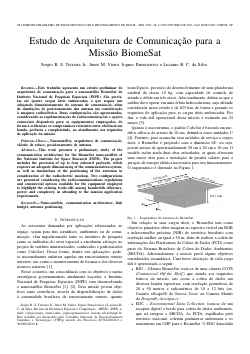
Estudo de Arquitetura de Comunicação para a Missão BiomeSat
Sergio Roberto Scocato Teixeira Junior, Juner M. Vieira, Jognes Panasiewicz, Luciano B C Silva
DOI: 10.14209/sbrt.2023.1570923324
Keywords: Nanossatélite arquitetura de comunicação cálculo de enlace posicionamento de antenas
Abstract
This work presents a preliminary study of the communication architecture for the BiomeSat nano-satellite of the National Institute for Space Research (INPE). The project includes the provision of up to four onboard payloads, which requires an adequate dimensioning of the communication system, as well as simulations of the positioning of the antennas in consideration of the radioelectric mockup. Two configurations are presented considering the radiocommunications regulations and commercial options (COTS) available for the equipment employed to highlight the existing trade-offs among bandwidth efficiency, power, and complexity, in attending to the mission application requirements.Download
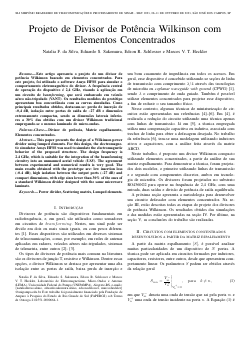
Projeto de Divisor de Potência Wilkinson com Elementos Concentrados
Natalia Ferrão da Silva, Eduardo Sakomura, Edson R. Schlosser, Marcos V. T. Heckler
DOI: 10.14209/sbrt.2023.1570923331
Keywords: Divisor de potência Matriz espalhamento Elementos concentrados
Abstract
Este artigo apresenta o projeto de um divisor de potência Wilkinson baseado em elementos concentrados. Para este projeto, foi utilizado o software Ansys HFSS para simular o comportamento eletromagnético do divisor. A frequência central de operação do dispositivo é 2,4 GHz, visando à aplicação em um circuito de beamforming, que será embarcado em veículo aéreo não-tripulado (VANT). Os resultados medidos do protótipo apresentam boa concordância com as curvas simuladas. Como principais resultados obtidos, destacam-se: perda de inserção de ~0,4 dB, isolação entre portas de saída de ~27 dB e dimensões extremamente compactas, sendo as dimensões laterais inferiores a 30% das obtidas com um divisor Wilkinson tradicional empregando-se o mesmo laminado de micro-ondas.Download
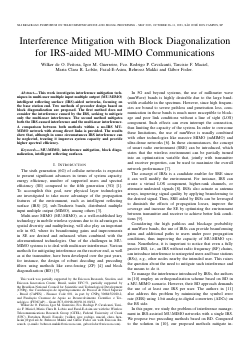
Interference mitigation with block diagonalization for IRS-aided MU-MIMO communications
Wilker de O Feitosa, Igor M. Guerreiro, Francisco R. P. Cavalcanti, Tarcisio F. Maciel, Maria Clara R. Lobão, Fazal-E- Asim, Behrooz Makki, Gabor Fodor
DOI: 10.14209/sbrt.2023.1570923333
Keywords: MU-MIMO Interference Mitigation Block Diagonalization Intelligent Reflecting Surfaces
Abstract
This work investigates interference mitigation techniques in multi-user multiple input multiple output (MU-MIMO) Intelligent Reflecting Surface (IRS)-aided networks, focusing on the base station end. Two methods of precoder design based on block diagonalization are proposed. The first method does not consider the interference caused by the IRS, seeking to mitigate only the multi-user interference. The second method mitigates both the IRS-caused interference and the multi-user interference. A comparison between both methods within an no-IRS MU-MIMO network with strong direct links is provided. The results show that, although in some circumstances IRS interference can be neglected, treating it can improve system capacity and provide higher spectral efficiency.Download
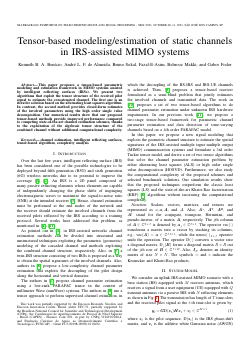
Tensor-based modeling/estimation of static channels in IRS-assisted MIMO systems
Kenneth Brenner Benício, André de Almeida, Bruno Sokal, Fazal-E- Asim, Behrooz Makki, Gabor Fodor
DOI: 10.14209/sbrt.2023.1570923345
Keywords: channel estimation intelligent reflecting surfaces tensor-based algorithm complexity analysis
Abstract
This paper proposes a tensor-based parametric modeling and estimation framework in MIMO systems assisted by intelligent reflecting surfaces (IRSs). We present two algorithms that exploit the tensor structure of the received pilot signal to estimate the concatenated channel. The first one is an iterative solution based on the alternating least squares algorithm. In contrast, the second method provides closed-form estimates of the involved parameters using the high order single value decomposition. Our numerical results show that our proposed tensor-based methods provide improved performance compared to competing state-of-the-art channel estimation schemes, thanks to the exploitation of the algebraic tensor structure of the combined channel without additional computational complexity.Download
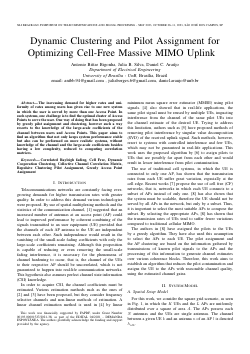
Dynamic Clustering and Pilot Assignment for Optimizing Cell-Free Massive MIMO Uplink
Antonio B Bigonha, Daniel Araújo, Julia B Silva
DOI: 10.14209/sbrt.2023.1570923346
Keywords:
Abstract
The increasing demand for higher rates and uniformity of rates among users has given rise to one new system in which the user is served by more than one Access Point. In such systems, one challenge is to find the optimal cluster of Access Points to serve the user. One way of doing that has been proposed by greedy pilot assignment and clustering, however such a way resorts to the knowledge of the large-scale coefficients of the channel between users and Access Points. This paper aims to find an algorithm that not only keeps system performance stable but also can be performed on more realistic systems, without knowledge of the channel and the large-scale coefficients besides having a low complexity, reduced to computing correlation matrices.Download
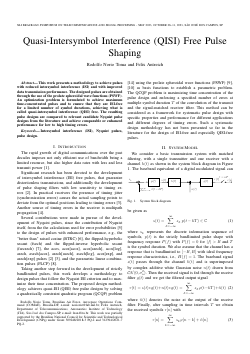
Quasi-Intersymbol Interference (QISI) Free Pulse Shaping
Rodolfo Norio Toma, Felix Antreich
DOI: 10.14209/sbrt.2023.1570923349
Keywords: Intersymbol interference (ISI) Nyquist pulses pulse design
Abstract
This work presents a methodology to achieve pulses with reduced intersymbol interference (ISI) and with improved data transmission performance. The designed pulses are obtained through the use of the prolate spheroidal wave functions (PSWF). An optimization problem is formulated to achieve maximum time-concentrated pulses and to ensure that they are ISI-free for a limited number of symbol durations, achieving what is called quasi-intersymbol interference (QISI) free. The resulting pulse designs are compared to relevant candidate Nyquist pulse designs from the literature and achieve comparable or enhanced performance for low to high timing errors.Download
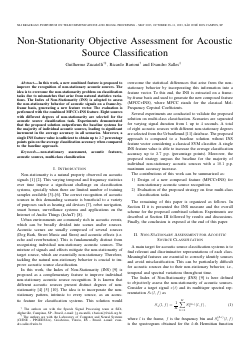
Non-Stationarity Objective Assessment for Acoustic Source Classification
Guilherme Zucatelli, Ricardo Rossiter Barioni, Evandro Salles
DOI: 10.14209/sbrt.2023.1570923353
Keywords: non-stationary assessment acoustic features acoustic sources multi-class classification
Abstract
In this work, a new combined feature is proposed to improve the recognition of non-stationary acoustic sources. The idea is to overcome the non-stationarity problem on classification tasks due to mismatches that arise from natural statistics variations. The Index of Non-Stationarity (INS) is adopted to assess the non-stationarity behavior of acoustic signals on a frame-by-frame basis, generating a new feature vector. The evaluation is performed with the combined MFCC+INS feature. Eight sources with different degrees of non-stationarity are selected for the acoustic source classification task. Experiments demonstrated that the proposed solution outperforms the baseline systems for the majority of individual acoustic sources, leading to significant increment in the average accuracy in all scenarios. Moreover, a single INS feature value is sufficient to obtain up to $2.7$ percentage points gain on the average classification accuracy when compared to the baseline approach.Download
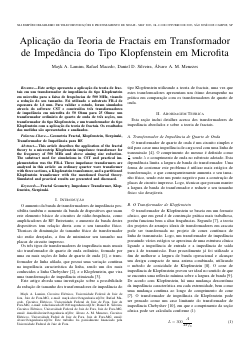
Aplicação da Teoria de Fractais em Transformador de Impedância do Tipo Klopfenstein em Microfita
Daniel D. Silveira, Mayk Lamim, Alvaro Augusto Machado de Medeiros, Rafael da Silva Macêdo
DOI: 10.14209/sbrt.2023.1570923354
Keywords: Geometria Fractal Klopfenstein Sierpinski Transformador de Impedância para RF
Abstract
Este artigo apresenta a aplicação da teoria de fractais em um transformador de impedância do tipo Klopfenstein em microfita para a faixa de frequências de 500 MHz e acima visando a redução do seu tamanho, utilizando o substrato FR-4 de espessura de 1,6 mm. Para validar o estudo, foram simulados através do software CST e construídos três transformadores de impedância em microfita de 50 Ohms para 25 Ohms: um transformador ordinário de quarto de onda de três seções, um transformador do tipo Klopfenstein, e um transformador do tipo Klopfenstein com a aplicação da teoria de fractais. Os resultados das medidas são apresentados e analisados.Download